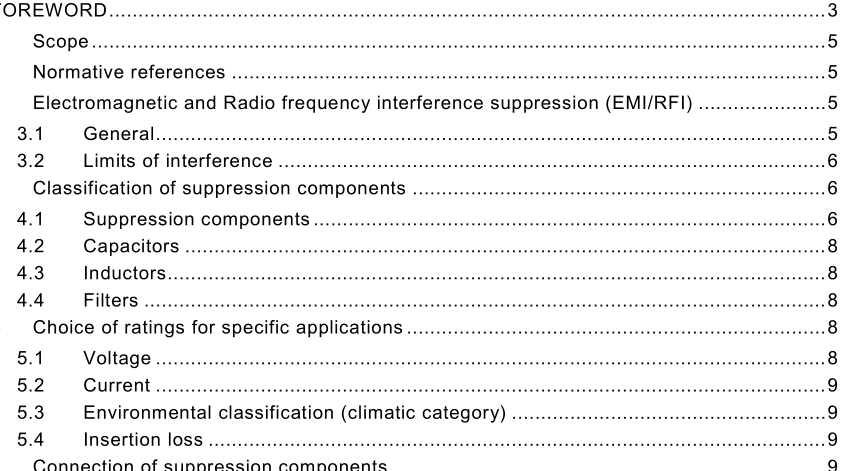IEC 60940-2015 pdf Guidance information on the application of capacitors, resistors, inductors and complete filter units for electromagnetic interference suppression

During operation, the capacitors are subjected to the supply mains voltage with a superimposed radio interference voltage. In many cases, the extra load caused by the radio- frequency voltage is not important, but in other cases an appreciable radio-frequency current through the capacitor may occur or high voltage peaks may be present. This must be taken into account when choosing the capacitor and a check should be made with the capacitor under its working conditions to make sure that its ratings are not exceeded. The presence of inductance in the supply circuits in series with the capacitor may cause the voltage at power frequency applied to the capacitor to exceed the supply voltage. For inductors using ferromagnetic cores, it is important to be aware of the possible loss of suppression caused by saturation of the core causing decrease of inductance. This saturation may be caused by peaks of load current or interference current, or continuous excessive load current. Unbalance of winding in current-compensated inductors will also contribute to the effect. The effectiveness of interference suppression is a function of suppression component construction, mounting of the component in the machine or apparatus, the radio-frequency voltage spectrum generated by the machine or apparatus and of characteristics of the external circuit. Due to the complexity of the problem it is not possible to estimate with sufficient accuracy from the radio-frequency characteristics of a component how effective it will be under various conditions. On the other hand, components for use under similar conditions can be compared on the basis of their radio-frequency characteristics. For this purpose the resonance frequency measured under given conditions and the radio-frequency resistive at resonance may be of use. For these reasons it is not required that the radio-frequency characteristics be marked on the components nor has it been attempted to standardize certain values for these characteristics.
- ISO IEC 27050-4-2021 pdf Information technology — Electronic discovery — Part 4: Technical readiness
- ISO IEC 27036-1-2021 pdf Cybersecurity — Supplier relationships — Part 1: Overview and concepts
- ISO IEC 27013-2021 pdf Information security, cybersecurity and privacy protection — Guidance on the integrated implementation of ISO/IEC 27001 and ISO/IEC 20000-1
- ISO IEC 26580-2021 pdf Software and systems engineering — Methods and tools for the feature- based approach to software and systems product line engineering
- ISO IEC 24735-2021 pdf Information technology — Office equipment — Method for measuring digital copying productivity
- ISO IEC 24711-2021 pdf Information technology — Office equipment — Method for the determination of ink cartridge yield for colour inkjet printers and multi- function devices that contain printer components
- ISO IEC 23544-2021 pdf Information Technology — Data centres — Application Platform Energy Effectiveness (APEE)
- ISO IEC 23510-2021 pdf Information technology — 3D printing and scanning — Framework for an Additive Manufacturing Service Platform (AMSP)
- ISO IEC 23127-1-2021 pdf Information technology — Learning, education, and training — Metadata for facilitators of online learning — Part 1: Framework
- ISO IEC 23126-2021 pdf Information technology for learning, education and training — Ubiquitous learning resource organization and description framework
- IEC 60800-2009 pdf Heating cables with a rated voltage of 300/500 V for comfort heating and prevention of ice formation
- ISO IEC 7816-8-2021 pdf Identification cards — Integrated circuit cards — Part 8: Commands and mechanisms for security operations
- ISO IEC 24711-2021 pdf Information technology — Office equipment — Method for the determination of ink cartridge yield for colour inkjet printers and multi- function devices that contain printer components
- IEC 62546-2009 pdf High Definition (HD) recording link guidelines
- IEC 61500-2009 pdf Nuclear power plants – Instrumentation and control important to safety – Data communication in systems performing category A functions
- BS ISO IEC 15420-2009 pdf Information technology一 Automatic identification and data capture techniques EAN/UPC bar code symbology specification
- BS ISO IEC 19762.5-2008 pdf Information technology一 Automatic identification and data capture (AIDC) techniques – Harmonized vocabulary Part 5: Locating systems
- BS IEC 60860-2014 pdf Radiation protection instrumentation一 Warning equipment for criticality accidents
- ISO IEC 24735-2021 pdf Information technology — Office equipment — Method for measuring digital copying productivity
- ISO IEC 24711-2021 pdf Information technology — Office equipment — Method for the determination of ink cartridge yield for colour inkjet printers and multi- function devices that contain printer components